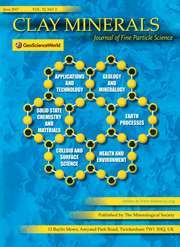Crossref Citations
This article has been cited by the following publications. This list is generated based on data provided by Crossref.
McRae, S. G.
and
Lambert, J. L. M.
1968.
A study of some glauconites from cretaceous and tertiary formations in South-East England.
Clay Minerals,
Vol. 7,
Issue. 4,
p.
431.
Fookes, Peter George
and
Best, Robert
1969.
Consolidation characteristics of some kate Pleistocene periglacial metastable soils of East Kent.
Quarterly Journal of Engineering Geology,
Vol. 2,
Issue. 2,
p.
103.
Hamblin, R. J. O.
1973.
The Clay Mineralogy of the Haldon Gravels.
Clay Minerals,
Vol. 10,
Issue. 2,
p.
87.
Hamblin, R.J.O.
1973.
The haldon gravels of South Devon.
Proceedings of the Geologists' Association,
Vol. 84,
Issue. ,
p.
459.
Loveland, P. J.
1984.
The soil clays of Great Britain: I. England and Wales.
Clay Minerals,
Vol. 19,
Issue. 5,
p.
681.
Derbyshire, E.
and
Mellors, T.W.
1988.
Geological and geotechnical characteristics of some loess and loessic soils from China and Britain: A comparison.
Engineering Geology,
Vol. 25,
Issue. 2-4,
p.
135.
Hamblin, Richard
2014.
The Palaeogene Haldon Formation of South Devon.
Proceedings of the Geologists' Association,
Vol. 125,
Issue. 5-6,
p.
591.


